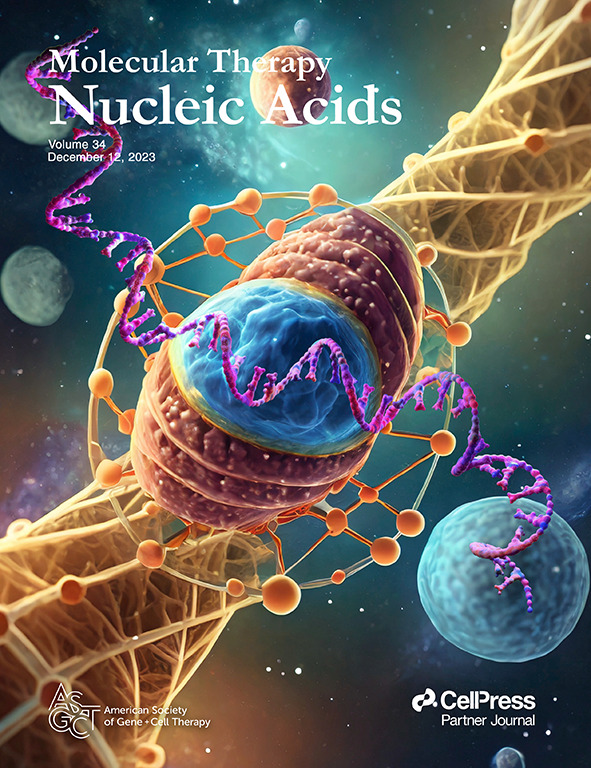表达功能性 miRNA 的转扩增 RNA 可介导靶标特异性基因抑制和同步转基因表达
IF 6.5
2区 医学
Q1 MEDICINE, RESEARCH & EXPERIMENTAL
引用次数: 0
摘要
微小核糖核酸(miRNA)和编码蛋白质核糖核酸的共同传递为基因表达和基因调控的综合治疗应用提供了机会。蛋白质递送是通过长 mRNA、自体和扩增 RNA(taRNA)实现的,而 miRNA 递送通常使用短合成寡核苷酸,而不是将其作为前体纳入长 RNA。虽然已经描述了使用长基因组 RNA 病毒将 miRNA 运送到细胞质中的情况,但人们仍然担心处理效率低。然而,miRNA 前体可以通过 Drosha 的细胞质部分从长的细胞质阿尔法病毒 RNA 中释放出来。taRNA 是一种很有前景的传染病疫苗载体平台,它使用表达阿尔法病毒复制酶的非复制 mRNA 来扩增.NET 中的蛋白编码短转录子 RNA(STR)。为了研究同时传递蛋白质表达和基因沉默的可能性,我们测试了 taRNA 系统能否携带并向靶细胞释放功能性 miRNA。在这里,我们发现成熟的 miRNA 可从 STR 中释放,并以复制依赖的方式沉默特定靶点达数天之久,而不会影响 STR 编码蛋白质的表达。我们的研究结果表明,将 miRNA 纳入 taRNA 载体平台有可能在表达治疗基因的同时进行基因调控。本文章由计算机程序翻译,如有差异,请以英文原文为准。
Trans-amplifying RNA expressing functional miRNA mediates target-specific gene suppression and simultaneous transgene expression
The co-delivery of microRNAs (miRNAs) and protein-coding RNA presents an opportunity for a combined approach to gene expression and gene regulation for therapeutic applications. Protein delivery is established using long mRNA, self-, and -amplifying RNA (taRNA), whereas miRNA delivery typically uses short synthetic oligonucleotides rather than incorporating it as a precursor into long RNA. Although miRNA delivery into the cell cytoplasm using long genomes of RNA viruses has been described, concerns have remained regarding low processing efficiency. However, miRNA precursors can be released from long cytoplasmic alphaviral RNA by a cytoplasmic fraction of Drosha. taRNA, a promising vector platform for infectious disease vaccination, uses a nonreplicating mRNA expressing an alphaviral replicase to amplify a protein-coding short transreplicon-RNA (STR) in . To investigate the possibility of simultaneously delivering protein expression and gene silencing, we tested whether a taRNA system can carry and release functional miRNA to target cells. Here, we show that mature miRNA is released from STRs and silences specific targets in a replication-dependent manner for several days without compromising the expression of STR-encoded proteins. Our findings suggest that incorporating miRNAs into the taRNA vector platform has the potential for gene regulation alongside the expression of therapeutic genes.
求助全文
通过发布文献求助,成功后即可免费获取论文全文。
去求助
来源期刊

Molecular Therapy. Nucleic Acids
MEDICINE, RESEARCH & EXPERIMENTAL-
CiteScore
15.40
自引率
1.10%
发文量
336
审稿时长
20 weeks
期刊介绍:
Molecular Therapy Nucleic Acids is an international, open-access journal that publishes high-quality research in nucleic-acid-based therapeutics to treat and correct genetic and acquired diseases. It is the official journal of the American Society of Gene & Cell Therapy and is built upon the success of Molecular Therapy. The journal focuses on gene- and oligonucleotide-based therapies and publishes peer-reviewed research, reviews, and commentaries. Its impact factor for 2022 is 8.8. The subject areas covered include the development of therapeutics based on nucleic acids and their derivatives, vector development for RNA-based therapeutics delivery, utilization of gene-modifying agents like Zn finger nucleases and triplex-forming oligonucleotides, pre-clinical target validation, safety and efficacy studies, and clinical trials.
 求助内容:
求助内容: 应助结果提醒方式:
应助结果提醒方式:


